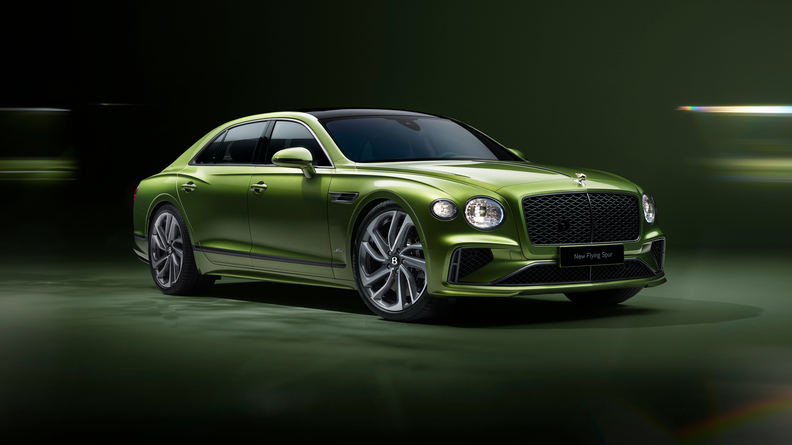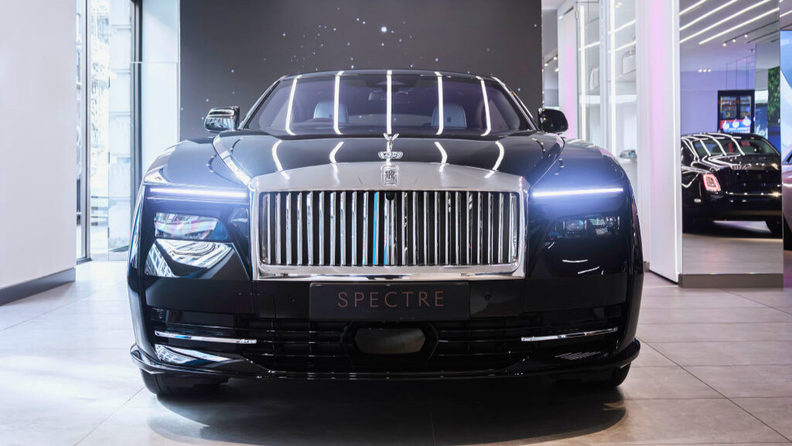
The ultraluxury four-door car gets a 19% power boost, along with a new electrical architecture.
Bentley has retained the design of its Flying Spur sedan for its fourth-generation model, with the biggest changes reserved for the powertrain and digital experience.
The new model gets the same V-8 plug-in hybrid powertrain as the newly launched Continental GT coupe and GTC convertible, making it the most powerful sedan in Bentley’s history, the company said.
The Flying Spur keeps the more traditional quadruple headlight design after the company chose not to switch to the more radical restyle applied to related Continental GT, which now has a new front end with dual headlamps
The Flying Spur Speed variant will go on sale first. Its electrified twin-turbocharged 4.0-liter V-8 replaces the 12-cylinder engine used by the current Flying Spur Speed model and increases power by 19 percent to 782 hp.
The Speed model will be supplemented at a later date by lower powered versions that are expected to use the same PHEV drivetrain as the Speed.
The power of the V-8 engine is boosted by a 187 hp electric motor fed by a 25.9 kilowatt-hour battery. Bentley said the sedan has a 76-km (47-mile) range on electric power only. This helps to reduce emissions by 90 percent compared to the W12 model if the car if the battery is kept charged.
Owners are not compelled to charge the battery, meaning real-life emissions could be significantly higher.
The Speed can accelerate from 0 to 100 kph (62 mph) in 3.5 seconds.
Versions of the same drivetrain are used by the new Porsche Panamera Turbo S E-Hybrid sedan and Lamborghini Urus SE SUV. Bentley, Porsche and Lamborghini are all part of Volkswagen Group and share technologies.
Bentley has prioritized the roll out of plug-in hybrids after delaying the unveiling of its first all-electric car by a year to 2026 and dropping its original plan to go BEV-only by 2030 because of the EV market’s slowdown.
The Flying Spur’s new drivetrain is an upgrade from the current plug-in hybrid set-up in the current Flying Spur, which uses a V-6 engine with a smaller 18 kWh battery.
Bentley has not disclosed prices for the new-generation model, but the Speed version is expected to cost around 220,000 pounds ($288,200) in its launch market of the U.K. Deliveries start in the fourth quarter.
Flying Spur sales were below those of the Bentayga SUV and Continental GT in the first half at 1,345, according to company figures.
Bentley’s largest market for the six months was the U.S. with 28 percent of its total 5,476 sales. Europe was second with 26 percent and China third with 21 percent.
New digital technology
The Flying Spur has a new electrical architecture, Bentley said. The Flying Spur, along with the Continental GT and GTC, shares a platform with the Porsche Panamera, allowing Bentley to port over technology.
New systems designed to enhance ride and handling include Bentley Dynamic Ride that uses air springs paired with new dual-valve damper. Also new is an all-wheel steering system and an electronically controlled limited slip differential.
Digital tech additions include the ability to add apps to the infotainment system independent of mobile phone integration via the company’s My Bentley App Studio. The feature was included to appeal to buyers in China where the average age of Bentley customers is much younger than in other markets.
Connectivity enhancements include the ability to park or summon the remotely from a mobile phone. Upgrades in the pipeline include green traffic light prediction where available in the U.S. and Europe.
New cabin ‘wellness’ features include a revision to the air conditioning system to including air ionizers, a new particulate matter filter and displays showing air quality outside and inside the vehicle.
The system also synchronizes with the car’s satellite navigation, knowing when it might be necessary to improve cabin air quality such as when driving through a tunnel.
Luxury focused additions to the cabin include a 3D relief effect diamond leather covering that extends to doors and pillars.


